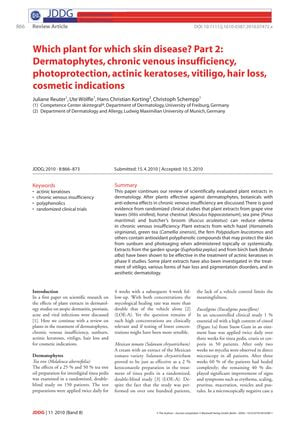Which Plant for Which Skin Disease? Part 2: Dermatophytes, Chronic Venous Insufficiency, Photoprotection, Actinic Keratoses, Vitiligo, Hair Loss, Cosmetic Indications
August 2010
in “
Journal der Deutschen Dermatologischen Gesellschaft
”

TLDR Certain plant extracts can effectively treat skin conditions like athlete's foot, chronic vein problems, sun damage, skin growths, vitiligo, and hair loss, and may also improve skin appearance.
The document from 2010 reviews the effectiveness of plant extracts in treating various skin conditions. Tea tree oil at 25% and 50% concentrations was found to significantly improve healing rates for tinea pedis in a study with 150 patients. A cream with Mexican tomato extract was also effective for tinea pedis. For chronic venous insufficiency, plant extracts like grape vine leaves, horse chestnut, sea pine, and butcher's broom reduced edema, with a study on 260 patients showing grape vine leaf extract as effective as compression stockings. Photoprotective properties were found in extracts like witch hazel, green tea, and cocoa, with carotenoids inhibiting UV-induced erythema. Ingenol mebutate gel treated actinic keratoses effectively in a study with 200 patients. For vitiligo, golden serpent fern extract combined with UVB phototherapy improved repigmentation in a study with 50 patients, and Ginkgo biloba extract showed positive results in a study with 52 participants. In hair loss treatment, onion juice promoted hair regrowth in a study with 38 participants, and saw palmetto fruit extract combined with B-sitosterol improved androgenetic alopecia in 26 patients. The document also discusses plant extracts for cosmetic uses, such as wrinkle reduction and scar improvement, but notes the need for more high-quality studies.






